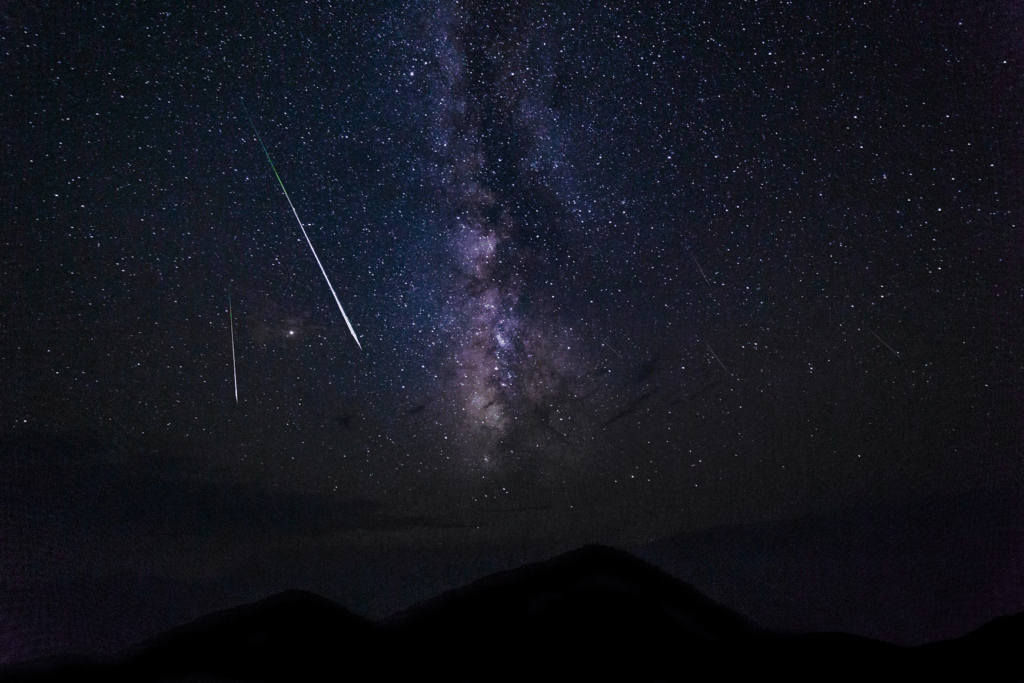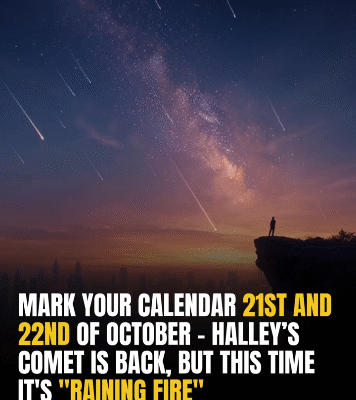Tonight, the heavens will put on one of the most mesmerizing shows of the year — the 2025 Orionid meteor shower. As Earth passes through the dusty remnants left behind by the legendary Halley’s Comet, tiny fragments will burn up in our atmosphere, creating streaks of light so bright they’ve been called “fiery rain.”
For skywatchers across the United States, this is more than a meteor shower — it’s a once-a-year reminder that our planet is constantly moving through cosmic history. The Orionids are not just beautiful; they’re ancient. Each glowing streak tonight will be a particle shed by Halley’s Comet hundreds, or even thousands, of years ago, before finally meeting its end in a blaze of light.
When To Watch The Orionid Meteor Shower
The Orionids reach their peak between Monday night, October 20, and the early hours of Tuesday, October 21, with the best viewing expected after midnight and before dawn. During these hours, the radiant — the spot in the sky where the meteors appear to emerge — climbs high above the horizon near the constellation Orion the Hunter.

If the skies stay clear, viewers in dark areas can expect 10 to 20 meteors per hour, each darting swiftly across the night sky at speeds of nearly 150,000 miles per hour. The meteors are fast, bright, and often leave glowing trails that linger for several seconds.
NASA calls the Orionids one of the most “dependably beautiful” meteor showers of the year — not as prolific as August’s Perseids, but often more striking in intensity. Their glow is usually bluish-green, caused by the vaporization of magnesium and other minerals as the particles hit the atmosphere.
Where To Look In The Sky
The Orionids take their name from Orion, one of the most recognizable constellations in the night sky. You can find it by spotting the famous three-star belt of Orion, rising in the east after midnight and climbing higher toward the south-southeast as morning approaches.
However, don’t stare directly at Orion itself — instead, look slightly away from the constellation for a wider view of the surrounding sky. Meteors can appear anywhere, and your best chance of spotting them is to let your eyes relax and take in as much of the night sky as possible.
How To Watch For Maximum Visibility
Catching the Orionids doesn’t require telescopes or fancy equipment — just patience and darkness. For the best experience:
- Find a dark location away from city lights and car headlights. Light pollution can wash out all but the brightest meteors.
- Give your eyes 20–30 minutes to adjust to the dark. Avoid looking at your phone or any bright screens during this time.
- Bring a blanket or reclining chair. Lying flat allows you to see more of the sky comfortably.
- Dress warmly — late October nights can be chilly, even in the southern states.
- Check the weather forecast. Cloudy skies can ruin visibility, so aim for areas with clear conditions.
If you’re in a region with minimal light pollution, such as rural or mountainous areas, you’ll be rewarded with a front-row seat to the universe’s light show.
The Science Behind The Orionids
The Orionid meteors are the offspring of Halley’s Comet, the most famous periodic comet known to humanity. Each year, as Earth crosses the path of the comet’s orbit, we plow through a trail of dust and debris it left behind on its countless journeys around the Sun.
Halley’s Comet itself only passes by Earth once every 75 to 76 years — the last time was in 1986, and it won’t return until 2061. But the particles it shed continue to meet us annually, creating the Orionids in October and the Eta Aquarids in May.
What makes the Orionids particularly fascinating is their longevity. Some meteors we’ll see tonight may have been released from Halley’s Comet thousands of years ago, long before telescopes or even written history. When they burn up in the sky, we’re witnessing the final moments of ancient cosmic dust that has traveled across the Solar System for millennia.
The Best Spots In America To Watch The Meteor Shower
If you want to escape the city glare and witness the Orionids in their full glory, these US locations offer some of the darkest skies and most breathtaking backdrops for stargazing:
1. Joshua Tree National Park, California
This desert wonderland, recognized as an International Dark Sky Park, offers one of the clearest night skies in North America. The arid air and low humidity make it a photographer’s dream for capturing meteors streaking over the rocky silhouettes of Joshua trees.
2. Anza-Borrego Desert State Park, California
Just a few hours from San Diego, this park boasts some of Southern California’s darkest skies. Its vast open landscape means unobstructed horizons — ideal for spotting meteors blazing across the heavens.
3. Big Bend National Park, Texas
Located along the Rio Grande, Big Bend is renowned for having the lowest light pollution in the continental US. On clear nights, even the faintest meteors leave luminous trails against a star-saturated sky.
4. Cherry Springs State Park, Pennsylvania
This park is often called the darkest spot on the East Coast. Visitors can see the Milky Way stretching overhead, and during meteor showers like the Orionids, the entire sky seems alive with movement.
5. Grand Canyon National Park, Arizona
The vast horizon of the Grand Canyon paired with its low humidity provides a spectacular canvas for meteor showers. Watching a meteor streak above the canyon rim is an unforgettable experience.
What Makes The Orionids So Special
While meteor showers happen several times a year, the Orionids hold a special charm. They’re known for producing fast, bright meteors that often leave persistent trails, glowing in the sky even after the meteor has vanished.
Many astronomers consider them a “hidden gem” — less crowded than the Perseids, yet equally breathtaking. The timing also makes them special: the crisp autumn air, longer nights, and early darkness make it the perfect stargazing season.
Another advantage this year is the moon phase. In 2025, the moon will be just a thin crescent during the Orionid peak, meaning minimal interference from moonlight. This will make even the faintest meteors easier to spot — a rare bonus for observers.
A Moment To Reflect Beneath The Falling Stars
There’s something deeply humbling about standing under the Orionid meteor shower. Every streak across the sky is a piece of ancient space dust, traveling for centuries only to vanish in an instant before our eyes.
As NASA astronomer Bill Cooke once said, “When you watch a meteor shower, you’re witnessing the universe writing in light.”
So tonight, take a moment to look up — whether you’re on a desert plateau, a quiet field, or your own backyard. Let the stars remind you how vast and connected this universe really is.
Because for just one night each October, Halley’s Comet leaves us a shimmering message across the dark canvas of the sky — a reminder that even the smallest fragments can create the brightest beauty.
